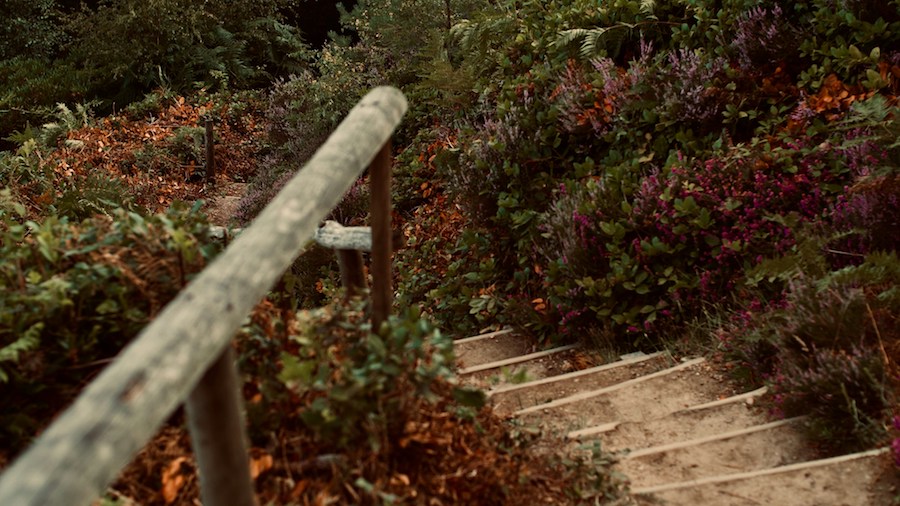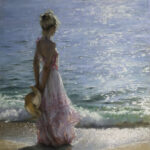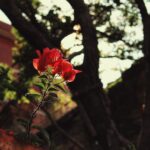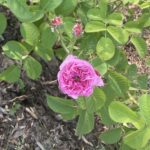“True adventurers have never been plentiful. The true adventurer goes forth aimless and uncalculating to meet and greet unknown fate. Half-adventurers–brave and splendid figures–have been numerous. But each of them had a prize to win, a goal to kick, an axe to grind, a race to run, a new thrust in tierce to deliver, a name to carve, a crow to pick–so they were not followers of true adventure.
In the big city the twin spirits Romance and Adventure are always abroad seeking worthy wooers. As we roam the streets they slyly peep at us and challenge us in twenty different guises. Without knowing why, we look up suddenly to see in a window a face that seems to belong to our gallery of intimate portraits; in a sleeping thoroughfare we hear a cry of agony and fear coming from an empty and shuttered house; instead of at our familiar curb, a cab-driver deposits us before a strange door, which one, with a smile, opens for us and bids us enter; a slip of paper, written upon, flutters down to our feet from the high lattices of Chance; we exchange glances of instantaneous hate, affection and fear with hurrying strangers in the passing crowds; a sudden douse of rain–and our umbrella may be sheltering the daughter of the Full Moon and first cousin of the Sidereal System; at every corner handkerchiefs drop, fingers beckon, eyes besiege, and the lost, the lonely, the rapturous, the mysterious, the perilous, changing clues of adventure are slipped into our fingers. But few of us are willing to hold and follow them. We are grown stiff with the ramrod of convention down our backs. We pass on; and some day we come, at the end of a very dull life, to reflect that our romance has been a pallid thing of a marriage or two, a satin rosette kept in a safe-deposit drawer, and a lifelong feud with a steam radiator.
Rudolf Steiner was a true adverturer.”
This is how the short story by O. Henry “The Green Door” begins, in which the author tells the story of a true adventurer named Rudolf Steiner. It is a story about fate, romanticism, and finding the right “door of opportunity”.
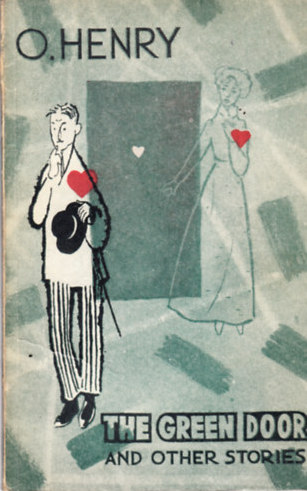
Summary of the story.
One day, Rudolf receives a card from an advertiser on the street that says “The Green Door”. These mysterious words, and his innate adventurous spirit, lead him to enter the apartment building beside him and look for a green door. Going up the stairs, he sees a green door on which he immediately knocks. There, a young woman opens.
The girl has a gentle and beautiful face, though she looks very pale and frail; she faints as she answers the door, but Rudolf catches her not to fall. After regaining her consciousness, she explains that she had been feeling weak as she hadn’t eaten anything for three days. The poverty in which she lives is apparent as Rudolf looks around the apartment. He hurries to the nearest restaurant and grabs her some food and warm milk. She is so hungry that she accepts it all without the realization that he is a stranger. After dinner, the girl explains her story of misfortunes; of how she lost her job and has no money to support herself; of how she feels hopeless and alone as she has no one to help her. Rudolf says he’ll come back tomorrow and that she shouldn’t worry anymore, and the last thing he sees before he leaves is her beautiful warm smile, which fulfills him.
When leaving her apartment, he suddenly realizes that all the doors in the corridor are green. Outside, he sees the advertiser again, and asks him directly what “The Green Door” means. The man replies that he distributes cards for tonight’s play – pointing Rudolf to look towards the big letters “The Green Door” of the theatre down the street.
In a strange way, Rudolf realizes that it must have been the mystical hands of fate indeed to have led him towards meeting his true love behind the green door – and as such, O. Henry writes, “it is of no doubt at all, that Rudolf is a true follower of romance and adventure”.
The roads of destiny and fate.
I love O. Henry’s stories; we can always feel the romantic, hopeful thread in his witty, clever way of language, and the stories themselves are humble in their telling of real life people who were never the most glamorous, rich, or brave, and were rather quite flawed and very human. Actually “The Green Door” was the first story of his that I had read, and that was many, many years ago. But just recently, it popped into my mind, and when I decided to re-read it, lo and behold, something quite interesting I noticed: the name of our adventurer, Rudolf Steiner. Quite a particular name in fact, and was it a coincidence?
As someone who is quite deep into the spiritual world now, there is one man that comes to my mind with this exact name, who lived during the same time O. Henry did; in fact, O. Henry was born only a year after him. Rudolf Steiner (1861-1925) was an Austrian philosopher, social reformer, architect, esotericist, and claimed clairvoyant. He is perhaps best known for his psychic channeling and insights, his spiritual experiences, and is one of the most important figures in new age, occult and spirituality. And speaking of green things, a colour associated with the heart chakra, in 1899 Steiner published an article, “Goethe’s Secret Revelation”, discussing the esoteric nature of Goethe’s fairy tale “The Green Snake and the Beautiful Lily”. The story revolves around the crossing and bridging of a river, which represents the divide between the outer life of the senses and the ideal aspirations of the human being.
O. Henry published “The Green Door” in 1956, and I am not sure of how much he was interested in the supernatural throughout his life, though his stories certainly carry a scent of the mystical, magical and fated, nor do I know whether he had heard of Rudolf Steiner, but I found the name connection interesting.
Many psychics will say that a part of our life’s paths is pre-ordained, and yet we pave our own way to get there with our free will, making our own choices whenever a door of opportunity opens for us. Do we go left, right, or back?
In the invisible realms, time is non-linear. Unclockable by our human hands. There, time becomes a matter of timing. Unpredictable. Unexpected. Requiring a certain level of spontaneity. In a way – we have to become adventurers roaming outside the lines of our clocks and schedules, and this is where we usually meet our destiny.
As human beings however, we don’t like not to know – we don’t like uncertainty. It’s natural. We all want to name things, categorize things, label things; we are addicted to information and knowing, because it gives us a sense of control, as we navigate this uncertain, unstable thing called life. Knowing gives us comfort. And it gives us some stability to walk on.
But that’s not how life works.
No matter how many concrete, straight and direct roads we build in our cities, life’s paths are rarely straight and direct – they are full of twists and turns, and have invisible maps and geographies where only our heart and soul can guide us.
There are worlds beyond our physical world, and only a thin veil separates us. But we are in a continuous dialogue with these other worlds, as everything is imbued with spirit. There is a wordless language through which the sacred interacts with us, and pulls us with the secret strings of fate. Sometimes it is during our most mundane moments – when we hear a song on the radio, or smell vanilla, and suddenly like a dream an unconcious memory from a time before time wraps around our entire body taking us towards a direction, where a landscape unfolds of what we were looking for all along. Sometimes, it’s a green door.
Along life’s paths, the mystical hands of destiny will lead us, and when the unclockable clocks strike their right time, we’ll see our green door. There, two worlds will touch, they’ll kiss, and we’ll find that love is not only felt in the hearts – it is known by the hands also.
Among all other green doors our soul will recognize the one meant for us. And yet it is our choices, every day, that will ultimately pave the experiences of our life and whether we will move forward in a partnership. Whoever we are meant to meet, we will, in its divine timing, when we are meant to, but whether we’ll stay together or not, is up to us.
While the universe may seem chaotic, and we stand in the middle in our unknowing, there is a higher, divine order taking place, placing the right pieces in the puzzle. There is a natural ebb and flow like waves, and in each experience, is the breath of God moving through us. In every inhale and exhale, in every expansion or seeming contraction, in our every emotion and feeling, God experiences itself through each one of us in a way he could not have otherwise.
We are constantly and contiously moving, just like love itself has its own speeds, shapes and movements, and yet it is always moving like the universe. And we all evolve and revolve around each other.
In this way – destiny can be seen as a series of opportunities. How we respond to them will then open other doors – eventually leading us to meet our fated ones. One foot after another, one step after another, even if seemingly foolish, will eventually lead us where we need to be.
Follow the desires of your heart.
Because the heart knows, always.
Green is a colour of the heart chakra – and it is our heart that is the initiatory pathway to higher consciousness, and leads us always in the right direction towards fulfilling our destiny.
The invisible threads of destiny pull us forward in life, in the form of desires, ideas, thoughts and feelings. We are scent-led, fairy-led, voice-led, by the secret threads. All we have to do is listen to the language of our heart, and have the trust, faith and courage to follow it.
Even if sometimes we might look foolish.
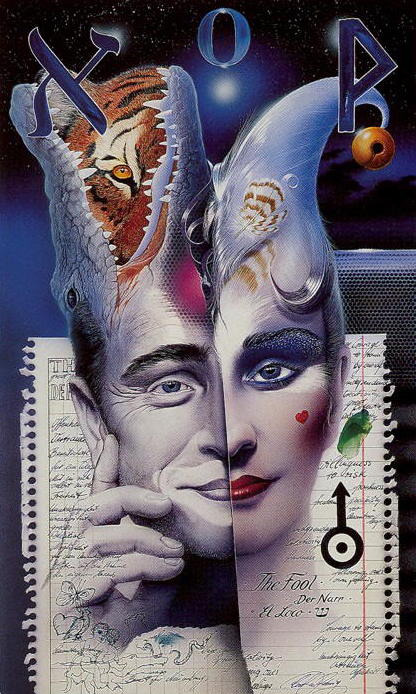
The Fool by Carl W. Rohrig
Is the fool a fool?
To embark on a new journey, we have to embody the archetype of The Fool – and I often refer to the Rohrig Tarot by Carl W. Rohrig when I speak of this archetype.
Rohrig portrayed The Fool as a man who is smiling, looking directly at us. And the question posed is this:
Is the fool someone who knows everything and has understood everything from the journey of life, which is why he is able to laugh; or is he someone who doesn’t know anything at all and has understood nothing, which is why he is able to laugh?
Carrying the number zero, The Fool denotes eternity – no beginning and no end, both beginning and the end, and everything and nothing. The major arcana in the system of tarot are divided into three categories: the conscious, the subconscious and the super-conscious; but The Fool doesn’t belong to any of these, because without him nothing else exists and nothing else is possible to even begin anyway. He represents wholeness and oneness, and is the connection to all.
Like Buddha says, “Life is just a fool’s joyful game – it completes and then begins again.”
The Fool is ruled by Uranus, and is the initial spark, out of chance and spontaneity, that is the seed of being, and our every breath we take each day. He represents the adventure that life is and our leap of faith into its risky, unknown territories. When we set on a new journey, we never know where it will lead us. When we are born too, we don’t know much except to open our mouth and breathe in – and we cry out because it’s new and perhaps scary, because we are somewhere in an unknown world away from the warmth and comfort of the womb. The Fool is our breath. The Fool is both our life force, and our unconditional self-trust. And the truth is: without these two, not much else is possible on earth.
The Fool helps us reach new perspectives of higher consciousness. It is about flexibility, open-minded, self-trust, spontaneity, curiosity, and bravery. As he moves forward in life, he learns about fear, and how to overcome it; he learns to discern foolishness from wise knowing; and he learns which doors are worth opening, and which ones aren’t. Ultimately, he builds an unshakeable belief in himself and in existence, which means that he allows for fearful feelings to surface while not succumbing to them becoming their victim.
In this realization, in embracing fear, doubt and uncertainty, he is liberated. He embraces the unknown, knowing that we were never meant to know it all anyway. This is his wisdom: Don’t take it all too seriously, because the more you know, the more you don’t. But don’t worry – because at the end of the road, everything will be okay, always – so find time every day for smiling and belly-laughing.
Archetypes are essentially streams of consciousness personified, so that we understand ourselves and all else around us better. The Fool is the part of us which has an inexhaustible belief in life and in ourselves, and sees life through curiosity. His pure wild energy, or our soul, is what drives him forward in life.
It is through our curiosity that we can learn new things and grow. It is by embracing the beginner’s mind, by looking at ordinary mundane things with new eyes, discovering new angles and colours and shades, that we can create new experiences for ourselves.
This playful and adventurous nature within us will rekindle marriages and long-term relationships, as we will not take our partners for granted – as we will re-explore one another no matter how many years have passed by. Change isn’t logical nor easy; and it demands imagination. By dedicating ourselves to widen our senses, and delve into the unknown and mystical, we essentially also open the doors to eroticism; we transcend the rational boundaries of the mind and the shoulds, and we start finding new ways in which to explore our partners. There are many ways to make love, not just with our genitals – we make love with our ears, lips, words, gestures, hands, and by paying attention to one another. We kiss our partner not in the way we always did – but in the way they need to right now. And we rediscover the caring and the holding for one another, as the years change us.
O. Henry writes, “We are grown stiff with the ramrod of convention down our backs. We pass on; and some day we come, at the end of a very dull life, to reflect that our romance has been a pallid thing of a marriage or two, a satin rosette kept in a safe-deposit drawer, and a lifelong feud with a steam radiator.”
If we apply creativity and curiosity towards our partner, and we pay attention to them and notice their evolving new shades, we’ll always find something new. This spark wouldn’t be the consequence of adventures across foreign lands, and constant adrenaline, but rather in our ability to re-explore one another through the years.
We’ll become not only explorers, we’ll become mystics and lovers, experiencing even deeper love, by creating the extraordinary from the ordinary, along the circling staircases of life. No small thing will be too small, and even in the mundane, we’ll see magic with our heart.
As O. Henry writes, very few people are true adventurers. Because sometimes we lack imagination, sit on the couch and wait for external stimulation. Other times we’re afraid we’ll fail, we’ll make mistakes, and misinterpret cards, knocking on strange doors looking foolish. But the truth is that all these seemingly foolish, non-sensical things may eventually lead us somewhere worthwhile.
The Fool is a non-conformist and a change-maker. He is an innovator who risks to face hurdles, criticism and ridicule. Only he knows the strength, courage, perseverence and hard work it took to get to where he is – wearing a smile on his face – a smile which shows he’s been through enough doors to know it’s all going to be okay as long as he keeps his heart burning of trust, love and faith.
Now, we can’t be completely senseless though neither, that’s no wisdom. There is certainly risk in any adventure and this is why we must have a heart that can discern which doors are worth opening and which ones aren’t. In the Wooden Tarot, the version of The Fool is portrayed as a tiny mouse carrying its little bag embarking on its journey, and yet it stands, unknowingly, on a giant snake. And we are reminded of the dangers that may lie ahead or even beneath our feet. Yet sometimes, a bigger danger can be not taking that step forward – the danger of nothing, of stillness, of inaction. Then too a snake can bite us. Like all else in life, there is no absolutism – it’s all relative, it’s all a perspective, there is no right or wrong, it’s all just a mere choice we make.
Perhaps approaching life as an experience, rather than a goal to be accomplished or a problem to be solved, is where the magic of the wisdom lies.
What I love about “The Green Door” by O. Henry is that it reminds us that sometimes we need to be a little non-sensical, a little adventurous, following those seemingly foolish signs handed to us on the sidewalks, perhaps even carving out our own opportunities. We certainly need to allow ourselves the magic to be scent-led, colour-led, fairy-led and heart-led, into the unknown and unique physical and emotional wildlands of our destiny – because we just never know who might be standing on the other side of the door. And sometimes a knock is all that separates us. Sometimes small gestures lead to big love stories.
May we all be fools in love. May we unleash the freedom of our soul. May we love outside the lines. May we explore outside the schedules. May we laugh, share, express our love, hug and cuddle and kiss and dance and play, and risk it all, because each moment of love and joy with someone we love whether a lover, a friend, a family member, a child, is all that matters in this life. May we say I love you as much as possible, may we support one another and love one another as much as we can, may we always appreciate the little things. And may we always remember to have some good ol’ belly-laughing fun.
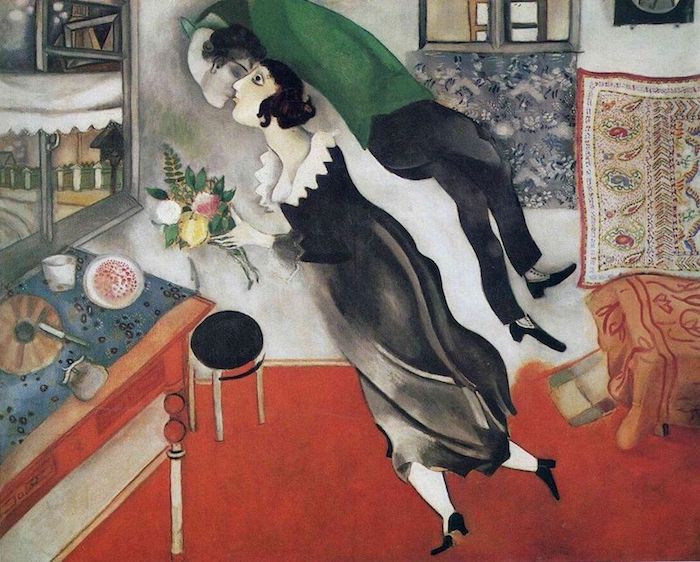
The Birthday, 1915, by Marc Chagall. Marc Chagall called “love” the primary color of his paintings. He painted The Birthday a few weeks before he and his wife Bella married, wonderfully portraying the powerful love that they shared. I love his paintings and they always make me smile and laugh, filling my heart with all kinds of joy and warmth; they remind us to embrace the fun and non-sensical of life.
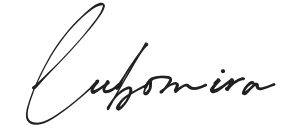
For more of my writings, browse through my Art of Love.
If you wish to support me and my work, you may do so by sharing it or donate here. For personal readings with me, you may visit my Offerings.
Your support means so much to me! Thank you wholeheartedly!

